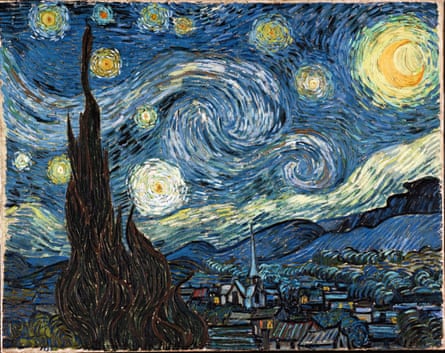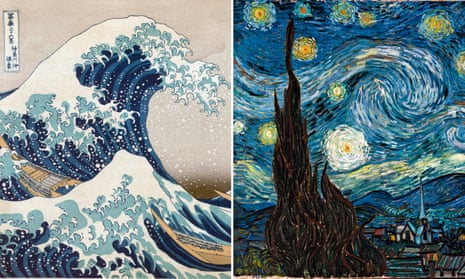One of the great masterpieces of 19th-century western art was loosely inspired by one of the greats of 19th-century Japanese art, it has been argued.
Martin Bailey, a specialist on Vincent van Gogh, believes that the Dutch artist drew inspiration from Katsushika Hokusai’s The Great Wave off Kanagawa when he painted one of his most dazzling and celebrated works, The Starry Night.
Side by side, the similarities are obvious. In the Hokusai the wave towers over the volcanic peak of Mount Fuji, Bailey said. In the Van Gogh, “the swirling mass in the sky hurtles towards the more gentle slopes of Les Alpilles”.
Art historians know that Van Gogh was a keen collector of Japanese prints. He particularly admired the Hokusai print, which is now one of the most recognisable and reproduced artworks of all time. In one letter to his brother Theo, he said: the “These waves are claws, the boat is caught in them, you can feel it.”
Starry Night was painted in the summer of 1889, when Van Gogh was in a small mental asylum on the outskirts of Saint-Rémy-de-Provence.
He was a voluntary patient, admitted after he cut off his ear and presented it, wrapped in paper, to a young woman in a local brothel.


Van Gogh was well aware that he could not live independently without help. “It must have been horrific moving into a mental asylum in the 19th century,” said Bailey, author of the recent published Starry Night: Van Gogh at the Asylum. “I did research on the other patients in the asylum and they were all in a terrible state so it must have been very, very difficult for him to adjust his life. I think it was art which kept him sane and gave him a reason to live.”
He painted Starry Night in June, inspired by the the night sky he looked up at through the bars of his cell and the stunning Provence landscape with wheat fields, cypress trees and olive groves.
Bailey argues that Van Gogh was also inspired, possibly unconsciously, by his memories of The Great Wave. “He didn’t have the print with him but he obviously remembered it in great detail. He had a very strong visual memory.”
The comparison should not be seen as diminishing the brilliance of Starry Night, Bailey said. The painting was “a work of imagination with all sorts of conscious and unconscious elements which must have come in to Vincent’s mind when he was doing the painting”.
But the similarities between the thrust of the wave and the swirling of the sky; that they are both striking studies in blue; and the fact that Van Gogh admired The Great Wave so much all point to a loose inspiration, said Bailey, who blogs about Van Gogh for the Art Newspaper and will discuss his book and theory at the Cheltenham Literature Festival on 5 October.
“It is surprising no one has made this comparison before. I’ve put it to a number of Hokusai and Van Gogh experts and they have all said it is a very interesting theory. It is difficult to prove but my feeling is that it is highly likely.”
Starry Night is regarded as one of Van Gogh’s masterpieces although the artist himself never regarded it that way.
“It is incredible,” said Bailey. “If you go to the Museum of Modern Art in New York [where Starry Night is on display] there are more people with their cameras out in front of it than probably any of the other paintings there.
“I love it and it is fascinating when you think of where it was created, this marvellous and optimistic picture created in the most difficult and challenging of circumstances. Who would imagine someone living in a mental asylum would be able to paint such a marvellous work?”
